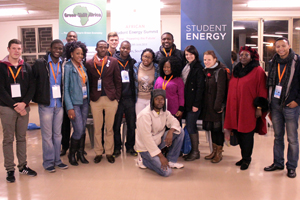
Kovsie students with the organisers at the African Student Energy Summit. Photo: Rirhandzu Marivate |
Powering the future. This was the theme of the first-ever African Student Energy Summit. The event was recently hosted by the Cape Peninsula University of Technology (CPUT) in Cape Town. The summit was even more unique, since it was part of a global series of Energy Summits held simultaneously in the US, Mexico and Scotland.
Sixteen Kovsies, together with students from across South Africa, Nigeria, Ghana, Zimbabwe, DRC, Zambia and Cameroon united at this event. The main goal: to confront pressing energy challenges faced by our continent. During roundtable discussions, these students brainstormed issues such as the accessibility of energy, as well as driving efficiency and sustainability through the use of green energy.
Antoinette Nel, a Kovsie honours student in Spatial Planning, said, “Interacting with different speakers and students on green energy possibilities enhanced my understanding of how much can be done to change the current status quo on energy in Africa.”
During a student parliamentary session, the participants had to come up with recommendations on sustainable energy. These will be compiled in a document and sent to the African Union (AU).
“My biggest highlight was understanding the need for energy by most Africans, not for lighting or industrialised activities but rather for daily livelihood, for basic rights and services such as cooking, health and education,” said Justman Suh, also an honours student in Spatial Planning at Kovsies.
“We are creating spaces to challenge Afro-pessimism in Africa through these platforms,” Dr Elizabeth Rasekoala, Chairperson of Green Shift Africa, said during the summit.